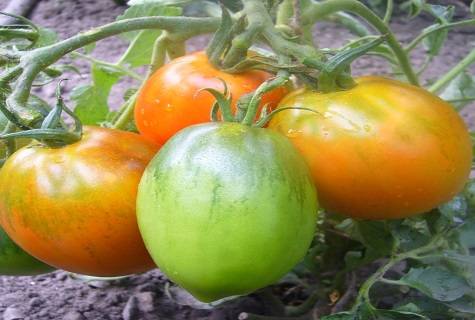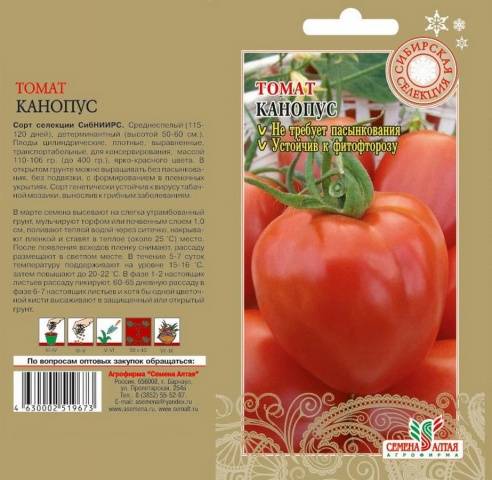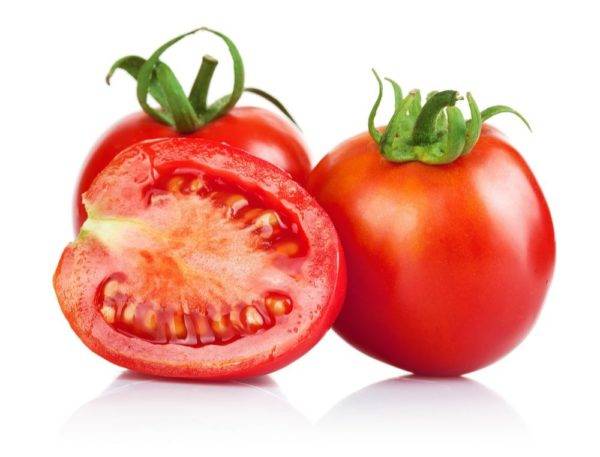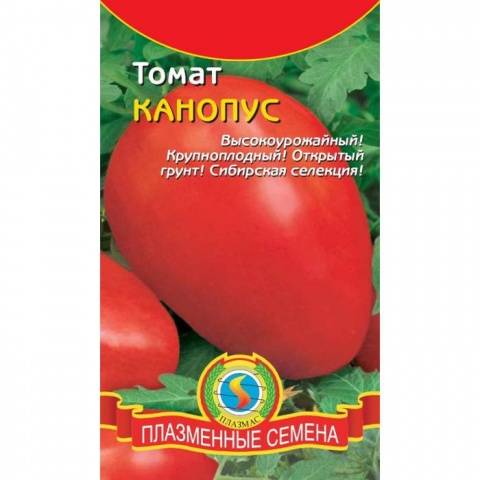Content
The name of the tomato variety alone can tell a lot about the ideas that its creators - breeders - put into it. Canopus is one of the largest and most significant stars in the sky, which is the second brightest of all stars visible from Earth after Sirius (not counting, of course, the Sun). Tomato Canopus, judging by its characteristics in the description of the variety, also occupies far from the last place in the seemingly endless world of tomatoes.
This tomato is able to interest both experienced farmers, due to its yield indicators, and novice summer residents due to its unpretentious care and resistance to many diseases and pests.
Description of the variety
The Canopus tomato variety was born about 20 years ago thanks to the efforts of breeders from the Institute of Cytology and Genetics, which is under the jurisdiction of the Siberian Branch of the Russian Academy of Sciences. Scientists of the research center of this institute have developed many interesting varieties of vegetables and, above all, tomatoes, which are particularly resistant to the vagaries of the weather and various manifestations of pathogenic organisms.
Since the Canopus variety comes from Siberia, more precisely, from Novosibirsk, it is most suitable for growing in the difficult conditions of the Siberian summer, as well as for all regions with similar climatic conditions. However, in other regions of Russia, they also appreciated the Canopus tomato and they are happy to grow it both in greenhouses and in ordinary beds in the open field.
By the way, this variety of tomatoes was registered in the State Register of Breeding Achievements of Russia back in 2000 and is recommended for cultivation throughout the country in open ground conditions.
Seeds of the Canopus variety are found on sale either directly from the manufacturer (SIBNIIRS) or in packages of seed companies located mainly beyond the Urals - "Seeds of Altai", "Uralsky Dachnik", "Agros", "Plasma Seeds".
Canopus tomato plants are determinant because they have limited growth. When grown outdoors, they do not need pinching or shaping.
A garter may be necessary, since, as a rule, a very large number of tomatoes are tied on the bushes and under their weight the bushes can fall to the ground and even break. In addition, tying the branches, and sometimes the fruit, often makes harvesting much easier. But with a large number of bushes in industrial cultivation, it is possible to do without a garter. In this case, the tomatoes may have to be picked directly from the ground.
Canopus tomato bushes are relatively compact in size, reaching a height of only 50-60 cm. Therefore, they can be easily planted in the beds at the earliest possible date, covering them with arcs with any non-woven material or film in the first few weeks.
The bushes of the Canopus variety have an average foliage and branching. Leaves of a traditional shape for tomatoes, dark green.
A simple inflorescence is formed only after 7-8 leaves, later they are laid either through one or two leaves.
If we talk about the timing of ripening, then the Canopus variety belongs to mid-season tomatoes - the vegetative period, starting from the moment full shoots appear, is approximately 115-120 days.
In terms of yield, the Canopus tomato rightfully belongs to the champions in the tomato world. It is not for nothing that this variety quickly attracted the attention of farmers and those who are trying to grow tomatoes mainly for sale. On average, the yield per square meter is 3 - 3.5 kg of commercial quality tomatoes. But with good care, the same amount of fruits can be obtained from one bush, and up to 5-6 kg of excellent quality tomatoes are harvested from a square meter.
The Canopus variety, in addition, is distinguished by its genetic immunity to the tobacco mosaic virus and good resistance to late blight and various kinds of bacterial spots. According to the experience and feedback of cultivation, various pests from the insect world also bypass it.
And, of course, a variety of Siberian tomato should be relatively easy to withstand various kinds of natural disasters, which is quite true for the Canopus tomato.
Characteristics of tomatoes
Tomato Canopus, according to its declared originator characteristics of tomatoes, belongs to a relatively rare type - it has oblong or almost oval fruits of rather large sizes. True, the shape of the fruit can vary greatly under different growing conditions. The earliest or largest tomatoes on the bushes often have a more traditional flattened shape. The smooth surface of the fruit may change and become slightly wrinkled at the base of the peduncle.
Most often, the average fruit size is small, the weight of one tomato can vary from 110 to 180 grams. But when using special growing techniques (forming into one stem, constant pinching and, of course, providing the maximum amount of sunlight and plenty of nutrition), you can get fruits from these tomatoes weighing up to 400 grams, or even more, each.
The color of Canopus tomatoes at the stage of technical maturity is green with a pronounced dark green spot in the region of the stalk. Fully ripe tomatoes are bright red in color.
Each tomato has more than 4 seed nests, the skin is quite dense, the pulp is firm, fleshy, with a sufficient juice content.
Canopus tomatoes have good taste characteristics, some are delighted with them, others consider them ordinary and even sour. In any case, the taste, as well as the size of the fruit, is highly dependent on the growing conditions and the amount as well as the quality of the nutrients introduced.
By design, Canopus tomatoes are of the universal type. They are good for salads in the summer, they make wonderful tomato products, such as ketchup, adjika, juice. And due to the relatively small size of most of the fruits, they are great for pickles and marinades.
Advantages and disadvantages
Most gardeners appreciate the following positive characteristics:
- High yield of bushes.
- Possibly large fruit sizes.
- Unpretentiousness in cultivation, including good fruit set in conditions of insufficient moisture.
- Resistance to a wide range of diseases and other adverse factors.
- Presentation of tomatoes, the possibility of their long-term storage and transportation.
The possible disadvantages of Canopus tomatoes cannot be ignored:
- Not the best taste and aroma of tomatoes - most gardeners use them mainly for processing.
Reviews of gardeners
Gardeners leave somewhat contradictory reviews about the Canopus tomato, which may indicate either the facts of re-grading, or that the quality characteristics of tomatoes still strongly depend on the growing conditions.
Conclusion
Canopus tomatoes are able to take their rightful place in any collection, since their unpretentiousness and resistance to diseases are well combined with high yields.














